Punjab Class 12 Biology Exam 2024 : Most Important Question with Answers
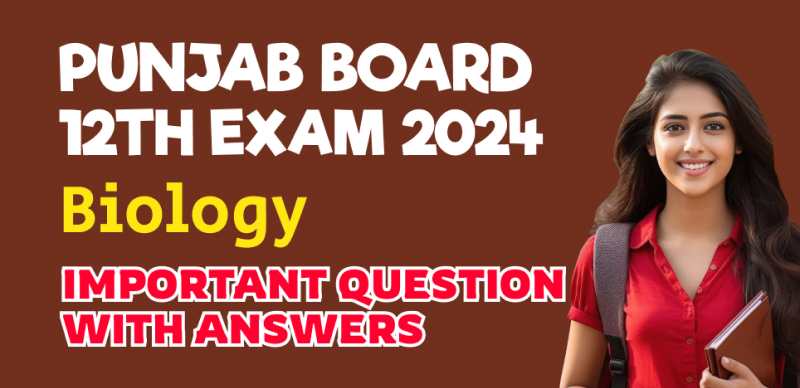
SHARING IS CARING
If our Website helped you a little, then kindly spread our voice using Social Networks. Spread our word to your readers, friends, teachers, students & all those close ones who deserve to know what you know now.
Class 12th Punjab Board Biology Students! Feeling exam pressure? Here is your ultimate study guide packed with super questions to help you succeed in your Biology exam, available in English Medium.
Covering all the major topics from the latest PSEB syllabus, we've got objective questions (MCQs) to test your memory and subjective questions (short answer and long answer) to challenge your understanding.
Whether you're aiming for a quick 1-digit answer or a detailed 5-digit explanation, we have questions to match your needs. Start practicing soon and crack your Class 12 Biology exam!
Multiple Choice Question
1. Meiosis does not occur in
(a) Asexually reproducing diploid individuals
(b) Asexually reproducing haploid individuals
(c) Sexually reproducing diploid individuals
(d) All of these
Ans. (a) Asexually reproducing diploid individuals
2.How are male honey bees born?
a) Parthenogenesis
b) Fragmentation
c) Eggs
d) Spores
Ans. (a) Parthenogenesis
3. Budding, in hydra, is a form of:
A. Apoptosis
B. Sexual reproduction
C. Asexual reproduction
D. None of the above
Ans. (C). Asexual reproduction
4.In monocot grafting is almost impossible because they lack
A. Cambium
B. Ground tissue
C. Vascular bundle
D. Parenchymatous cell
Ans. A Cambium
5. What is the most important event in sexual reproduction?
a. Fusion of gametes
b. Secondary sexual organs
c. Temperature
d. Environmental factors
Ans. a. Fusion of gametes
6.Ovum or eggs are formed in
a. Ovary
b. Testes
c. Uterus
d. Ovident
Ans. (a) ovary
7. Which among the following plays a vital role in pollination of pollengrains?
A.Petals
B.Sepals
C.Pedicel
D.Carpel
Ans. A.Petals
8.What happens to tapetum on maturity
a. it persist
b. it becomes sticky
c. it is eaten up and degenerates
d. it became fibrous
Ans. c , it is eaten up and degenerate
9. Development and formation of pollen grains in anther of the stamen is known as
A) Pollination
B) Fertilization
C) Microsporogenesis
D) Megasporogenesis
Ans. C) Microsporogenesis
10. Filiform apparatus is found in which part of angiosperms
A) Sperm
B) Antipodal
C) Egg
D) Synergid
Ans. D) Synergid
11. In which type whole of the megaspore mother cell takes part in the formation of the female gametophyte
A) Monosporic 8 nucleate
B) Monosporic 4 nucleate
C) Bisporic
D) Tetrasporic
Ans. D) Tetrasporic
12. Which one of the following character causes cross pollination
A) Cleistogamy
B) Dichogamy
C) Homogamy
D) All the above
Ans. B) Dichogamy
13. Which one of the following character causes cross pollination
A) Cleistogamy
B) Dichogamy
C) Homogamy
D) All the above
Ans. B) Dichogamy
14.During emasculation we remove
a. all the stamens
b. all the pistils
c. all the stigma
d. all of these
Ans. a. all the stamens
15. Bagging is done to
(a) Achieve desired pollination
(b) Prevent contamination of unwanted pollen
(c) Avoid self pollinatin
(d) Avoid cross pollination
Ans. (b) Prevent contamination from unwanted pollen
16.After double fertilization, angiosperm ovule develops into
a. Fruit
b. Endosperm
c.Perisperm
d. Seed
Ans. d. Seed
17. Dicot embryo consists of
A) Radicle and plumule
B) Radicle, plumule, cotyledons and sometimes endosperm
C) Radicle, plumule, cotyledons and tegmen
D) Radicle, plumule, cotyledons, tegmen and testa
Ans. B) Radicle, plumule, cotyledons and sometimes endosperm
18.On the basis of endosperm seed is of
a. four type
b. two type
c. three type
d. five type
Ans. b. two type
19. Parthenogenesis is development of new individual from
a) A single gamete without fertilization
b) Fertilization of female gamete with female gamete
c) Fertilization of male gamete with male gamete
d) Vegetative structure
Ans. a) A single gamete without fertilization
20. Why testicle are located in scrotum sac?
a. to keep low temperature than environment
b. to keep high temperature than environment
c. to keep two degree lower temperature than body
d. to keep two degree higher temperature than body
Ans. c. to keep two degree lower temperature than body
21. In mammals the estrogens are secreted by the Graafian follicle from its
a) External theca
b) Internal theca
c) Zona Pellucida
d) Corona radiate
Ans. b) Internal theca
22. Which of the following cell have primary function to divide by the meiosis process:
a) Primary oocyte
b) Ootid
c) Ovum
d) Secondary oocyte
Ans. a) Primary oocyte
23. Fimbriated funnel is
A) Proximal part of oviduct
B) Uterus part
C) Urinary bladder part
D) Ureter part
Ans. A) Proximal part of oviduct
24. Function of testis is
a. Production of sperm
b. Production of testosterone
c. Both of these
d. None of these
Ans. c. Both of these
25. Spermatogonia present
a. inside the wall of seminiferous tubules
b. outside the wall of seminiferous tubules
c. inside the wall of interstitial space
d. inside the wall of interstitial space
Ans. a. inside the wall of seminiferous tubules
26. In follicular phase
a. endometrium start regenerate
b. follicle start developing
c. FSH and LH level increases
d. all of these.
Ans. d. all of these.
27. In human females, the fertilized eggs get implanted in the uterus after:
a) One month of fertilization
b) Two months of fertilization
c) Seven days of fertilization
d) Three weeks of fertilization
Ans. c) Seven days of fertilization
28. What is the reflex that leads to the expulsion of baby called?
a. Feet withdrawal reflex
b. Knee jerk reflex
c. Fetal ejection reflex
d. Oxytocin reflex
Ans. c. Fetal ejection reflex
29. What is our main goal to control population growth?
a) Decrease in death rate
b) Decreasing the birthrate
c) Organizing several programs
d) Promote family planning programs
Ans. b) Decreasing the birthrate
30.What is the early symptoms of STD?
a.Itching and swelling
b.fluid discharge
c.slight pain
d. all of these
Ans. d. all of these
31. Which of the following is true about condoms?
a) These are barrier method
b) They prevent the entry of sperms in female reproductive tract
c) They prevent from STDs
d) All the above are true
Ans. d) All the above are true
32. The birth control device used by women is
a) Diaphragm
b) Vault
c) Copper T
d) All of these
Ans. d) All of these
33.How many days are required for the Amniocentesis tests results?
a) 1 day
b) 1-2 days
c) 1-2 weeks
d) 3-4 weeks
Ans. d) 3-4 weeks
34. In which Assisted Reproductive technology fertilization occurs in a woman’s body?
a) IVF
b) ZIFT
c) GIFT
d) ART
Ans. c) GIFT
35. The alternate form of a gene is:
a) Alternate type
b) Recessive character
c) Dominant character
d) Allele
Ans. d) Allele
36. Antiserum is:
a) blood serum containing specific antibodies
b) blood serum containing specific antigens
c) blood serum containing a mixture of antigens and antibodies
d) blood serum in which antigens and antibodies are both absent
Ans. a) blood serum containing specific antibodies
37. Mendel’s formulated the law of purity of gametes on the basis of:
a) Test cross
b) Back cross
c) Monohybrid cross
d) Dihybrid cross
Ans. c) Monohybrid cross
38. Which of the following blood groups show Co dominance?
a. Blood group A
b. Blood group B
c. Blood group O
d. Blood group AB
Ans. b. Blood group B
39. Which of the following is a classic example of polygenic inheritance?
a) Skin colour in humans
b) Blood groups
c) Flower colour in peas
d) Stem height in peas
Ans. a) Skin colour in humans
40. Which of the following statements is true about chromosomes?
a) They are colored bodies
b) They double before cell division
c) They are responsible for transmission of characters from parents to children
d) All of the above
Ans. d) All of the above
41. Percentage of crossing over is more when
a) genes are located in a different cell
b) genes are not linked
c) linked genes are located close to each other
d) linked genes are located far apart from each other
Ans. b) genes are not linked
42. Which condition describes the sex correctly
a) XO condition as in Turner’s Syndrome
b) XX sex chromosome produce male in Drosophila
c) ZZ sex chromosomes determines female sex in birds
d) XO sex chromosomes determine male sex in Grasshopper
Ans. d) XO sex chromosomes determine male sex in Grasshopper
43. Which of the following shows criss-cross inheritance?
a) Haemophilia
b) Colorblindness
c) Sickle cell anaemia
d) Both a and b
Ans. d) Both a and b
44. Pedigree analysis provides information about
a) Transmission of Color blindness
b) Transmission of malaria
c) Transmission of Cancer
d) All of the above
Ans. a) Transmission of Color blindness
45. Albinos lack which pigment in their skin?
a) Homogenistic acid
b) Haemoglobin
c) Melanin
d) None of the above
Ans. c) Melanin
46. How can a female be haemophilic?
a) Mother is haemophilic and father is normal
b) Mother is a carrier and father is haemophilic
c) Both mother and father are carriers
d) Both mother and father are haemophilic
Ans. b) Mother is a carrier and father is haemophilic
47. Which of following is a Chromosomal disorder?
a) Haemophilia
b) Sickle Cell anaemia
c) Red green colour blindness
d) Klinefelter’s syndrome
Ans. d) Klinefelter’s syndrome
48. Nucleic acids are polymer of
a) Nucleosides
b) Proteins
c) Glycoproteins
d) Nucleotides
Ans. b) Proteins
49. How many bp are present in a typical nucleosome?
a) 200 bp
b) 100 bp
c) 300 bp
d) 90 bp
Ans. b) 100 bp
50. Who proved that DNA was indeed the genetic material through experiments?
a) Alfred Hershey and Maclyn McCarty
b) Oswald Avery and Maclyn McCarty
c) Oswald Avery and Martha Chase
d) Alfred Hershey and Martha Chase
Ans. d) Alfred Hershey and Martha Chase
SHORT ANSWER TYPE QUESTIONS:
Q 1. Why organism produced by asexual reproduction is referred as clone?
Ans. Clone means exactly similar or carbon copy of their parents. Asexual reproduction does cause any genetic variation in organisms because there is no formation of gametes and only one parent is involved.
Q2. What is gametogenesis?
Ans. Hint: It is the process of formation of male and female gametes. Gametes are haploid cells which may be similar or dissimilar in structure.
Q3. What is germ pore?
Ans. Pollen grain exine has prominent apertures called germpores where sporopollenin is absent. Pollen grains are well – preserved as fossils. The exine exhibits a fascinating array of pattern and design.
Q4. Write the uses of pollen banks.
Ans. Store Pollen can be used as Pollen banks, they are used or prove helpful in crop breeding programs.
Q5. Arrange the following in correct developmental Sequence :-
Pollen grain, sporogenous tissue, microspore tetrad, pollen mother cell, male gamete.
Ans. Sporogenous tissue, pollen mother cell, microspore tetrad, pollen grain, male gametes.
Q6. What are apocorpus and syncorpus pistil?
Ans. 1. Apocarpous and Syncarpous Pistils:
These terms describe how carpels, the seed-bearing structures in flowers, are arranged within the pistil.
-
Apocarpous pistil: Here, two or more carpels remain separate. Each carpel forms its own individual pistil with a distinct ovary, style, and stigma. This results in multiple ovaries in a flower, and each carpel can develop into a separate fruit (e.g., strawberry, buttercup).
-
Syncarpous pistil: In contrast, multiple carpels fuse to form a single pistil. There's only one ovary, style, and stigma. The fused carpels develop into a single fruit (e.g., mango, tomato).
Q7. What is egg apparatus?
Ans. The egg apparatus is a specialized group of three cells within the embryo sac of flowering plants. It plays a crucial role in reproduction:
- Location: Found at the micropylar end (the pollen entry point) of the embryo sac.
- Components:
- Egg cell: This single cell fuses with a sperm cell during fertilization to form a zygote, which develops into the embryo.
- Synergids (2): These supportive cells help guide pollen tubes towards the egg cell and may secrete nutrients. They degenerate after fertilization.
Q8. What do you mean by monosporic development of female gametophyte?
Ans.
- Refers to the formation of the female gametophyte (embryo sac) in flowering plants from a single functional megaspore.
- Out of four megaspores produced by meiosis, only one survives and undergoes further mitotic divisions.
- This single megaspore develops into the mature embryo sac with egg and other reproductive cells.
Q9. Write a note on characters of hydrophilous flowers.
Ans. Certainly! Here’s a concise note on the characteristics of hydrophilous flowers:
- Small and Inconspicuous: Hydrophilous flowers tend to be small and inconspicuous.
- Unwettable Floral Parts: The perianth (the outer floral parts) and other components of hydrophilous flowers are unwettable.
- Long, Unwettable Pollen Grains: These flowers produce long pollen grains that are also unwettable due to the presence of mucilage.
- Lack of Nectar and Fragrance: Unlike many other flowers, hydrophilous flowers lack nectar and fragrance.
Q10. Write a note on differences between anemophilous & entomophilous flowers.
Ans. These terms describe how flowers attract pollinators:
-
Anemophilous (Wind-pollinated):
- Small and inconspicuous: Don't need to attract insects visually.
- Reduced petals: Save energy by having fewer petals.
- Light, dry pollen: Produced in large quantities to travel on wind.
- No scent or nectar: Not needed to attract insects.
-
Entomophilous (Insect-pollinated):
- Showy flowers: Bright colors and large petals attract insects.
- Scented: Pleasant smells lure pollinators.
- Sticky pollen: Clings to insects' bodies for transport.
- Nectar production: Rewards insects for pollination.
Q11. What is triple fusion? Name the nuclei involved in triple fusion. Where does it take place?
Ans.
-
Triple Fusion:
- Triple fusion is a crucial process involved in the sexual reproduction of angiosperms (flowering plants).
- It occurs during double fertilization within a seed-bearing plant.
- The fusion process takes place in the embryo sac of the angiosperms.
-
Nuclei Involved in Triple Fusion:
- During triple fusion, three nuclei participate:
- Sperm Nucleus: One of the male gametes (sperm) fuses with the egg cell nucleus, resulting in the formation of the zygote (this process is called syngamy).
- Two Polar Nuclei: The other male gamete combines with two polar nuclei located in the central cell of the embryo sac.
- The outcome of this triple fusion is the formation of a triploid endosperm nucleus.
- During triple fusion, three nuclei participate:
-
Location:
- Triple fusion occurs within the embryo sac of the angiosperms.
Q12. Define porogamy and chalazogamy.
Ans.
-
Porogamy: It is a type of pollination where the pollen grains are transferred from the anther to the stigma of the same flower. In other words, it involves self-pollination within the same flower.
-
Chalazogamy: This is another form of pollination where the pollen tube grows from the chalaza (base of the ovule) to the micropyle (opening of the ovule) without the need for pollen grains to be transferred externally. It occurs within the ovule itself.
Q13. Which are the nuclei that fuse to form endosperm?
Ans. The second male gamete fuses with secondary nucleus (which is formed by fusion of two polar nuclei) to form a triploid primary endosperm.
Q14. Which is the most common type of endosperm development?
Ans. The most common type of endosperm development is free-nuclear, in which the PEC undergoes successive nuclear division to give rise to a number of free nuclei. The endosperm thus formed is called free nuclear endosperm.
Q15. What are parthenocarpic fruits?
Ans. These are seedless fruits, produce without the process of fertilization.
Q16. What is meant by Emasculation ?
Ans. Technique of removal of stamens or anthers of bisexual flowers without affecting female reproductive organ
Q17. How is it that the embryo sacs of some apomictic species look normal but contain diploid cells?
Ans. Many apomicts posses normal looking embryo sacs. The only possibility of the embryo sac possessing diploid cells is due to failure of meiotic division at the megaspore mother cell stage. Since the megaspore mother cell has a diploid nucleus, if it undergoes mitosis instead of meiosis, all the resulting nuclei and cells will be diploid in nature.
Q18. Why are humans’ testes located outside the abdominal cavity? Name the pouch in which they are present.
Ans. Human testes are located outside the abdominal cavity as it helps in Maintaining low temperature, (2-2.5°C lower than body temperature), Required for spermatogenesis. Testes are enclosed in a pouch called Scrotum.
Q19. State the role of the epididymis in male fertility.
Ans. It is situated along the posterior surface of each testis where spermatozoa acquire motility and the capacity to fertilize the egg. The surface of the sperm is altered in response to secretions of the epididymis, which is key to achieve the ability to fertilize an egg.
Q20.Draw well labelled diagram of ovum.
Ans.
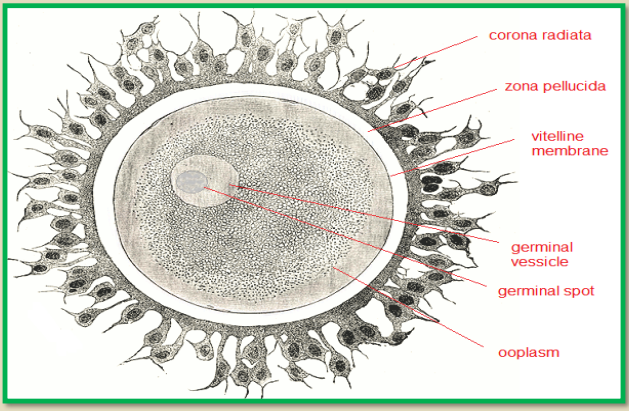
Q21. What are animal and vegetal poles in ovum?
Ans. The side of the ovum to which polar bodies are present is known as animal pole,where as the opposite side is known as vegetal pole.
Q22. DIFFERENTIATE BETWEEN SPERMATOGENESIS AND SPERMIOGENESIS.
Ans.

Q 23. Define corpus luteum.Name two hormones secreted by it.
Ans. (1) It provides nutrition to the developing embryo.
(2) It helps in respiration of the developing embryo.
(3) It secretes the wastes of the develping embryo so helps in excretion
Q 24. What is colostrum ? Why is it preferred over normal milk
Ans. Milk produced during the initial few days of lactation is called COLOSTRUM. It is preferred over normal milk because it is rich in proteins and calories, and also contains certain antibodies which provide passive immunity to the new born.
Q 25. When and Where do chorionic villi appear in humans ? State their function.
Ans. Chorionic villi arise from the surface of blastocyst during placentation.These fit into crypts of endometrium of uterus.Finally CHORIONIC VILLI and UTERINE MUCOSA form true PLACENTA which helps in nutrition, respiration and excretion of embryo and also maintains pregnancy.
Q 26. Differentiate between major structural changes in human ovary during follicular and luteal phase of the menstrual cycle.
Ans:During follicular phase of menstruation, the primary follicles in the ovary grow to become the mature Graffian follicle. The increase in LH and FSH stimulates the follicular development as well as secretion of estrogens by the growing follicles. At midcycle, there is an LH surge which causes the Graffian follicle to rupture and release the ovum. This is followed by the Luteal phase. In luteal phase, formation of corpus luteum occurs that starts secreting the hormone progesterone which maintains the uterine endometrium and keeps it ready for implantation.
Q 27.What is the major composition of seminal fluid?
Ans:The secretion of accessory glands (a pair of seminal vesicles, a prostate gland, a pair of cowper’s gland) of the male reproductive system and mucus constitute seminal plasma or seminal fluid. Seminal plasma along with sperms is called as semen. Seminal plasma is an alkaline fluid which contains fructose, calcium, certainenzymes, mucus, ascorbic acid, citrate and prostaglandins.
Q28. Differentiate between major structural changes in human ovary during follicular and luteal phase of the menstrual cycle.
Ans: During follicular phase of menstruation, the primary follicles in the ovary grow to become the mature Graffian follicle. The increase in LH and FSH stimulates the follicular development as well as secretion of estrogens by the growing follicles. At midcycle, there is an LH surge which causes the Graffian follicle to rupture and release the ovum. This is followed by the Luteal phase. In luteal phase, formation of corpus luteum occurs that starts secreting the hormone progesterone which maintains the uterine endometrium and keeps it ready for implantation.
Q29.Placenta acts as an endocrine tissue. Justify.
Ans: Placenta produces several hormones like human chorionic gonadotropin (hCG), human placental lactogen (hPL), estrogens, progestrone etc. In later stages of pregnancy, a hormone relaxin is also produced by it. Hence, calling placenta an endocrine tissue is justified.
Q30.What is the major composition of seminal fluid?
Ans: The secretion of accessory glands (a pair of seminal vesicles, a prostate gland, a pair of cowper’s gland) of the male reproductive system and mucus constitute seminal plasma or seminal fluid. Seminal plasma along with sperms is called as semen. Seminal plasma is an alkaline fluid which contains fructose, calcium, certainenzymes, mucus, ascorbic acid, citrate and prostaglandins.
LONG QUESTIONS TYPE QUESTIONS:
1. Explain the gamete transfer process during sexual reproduction in organism.
Ans. The transfer of gametes during sexual reproduction varies depending on the organism and environment. Here's a general overview:
- Animals:
- External fertilization: Sperm are released into the surrounding environment (water for aquatic animals) to meet eggs released by the female. (e.g., fish, amphibians)
- Internal fertilization: Sperm are deposited inside the female's body, where they fertilize the eggs. (e.g., mammals, birds)
- Plants:
- Wind pollination: Light, dry pollen grains are carried by wind to reach the female stigma. (e.g., grasses)
- Animal pollination: Colorful, fragrant flowers attract insects or other animals that transfer pollen grains between flowers. (e.g., roses, sunflowers)
- Water pollination: In aquatic plants, pollen travels through water to reach the female reproductive structures. (e.g., pondweed)
Q2. Describe embryogeny in monocots.
Ans.The formation of embryo is called embryogeny. It can be described in the following steps:
(i) The oospore divides transversely to form basal cell at micropylar end and terminal cell.
(ii) The basal cell enlarges and called suspensor cell or haustorium.
(iii) The terminal cell divides transversely to form two cells. The lower cells divide by mitosis number of times to form plumule and single cotyledon (scutellum).
(iv) Scutellum grows fast and pushes plumule to one side Plumule lies in a depression.
(v) The middle cell below suspensor divides to form radicleand hypocotyl. It also increases the suspensor by adding cells. The radicle and plumule are covered by colerrhiza and coleoptile respectively.
3. Explain the first major event taking place in a flowering plant after fertilization.
Ans. (Hint): The following events after double fertilization are collectively called Post Fertilization Events:
1. Development of Endosperm from primary endosperm nucleus (PEN).
2. Development of Embryo from Zygote.
3. Development of Seeds from Ovule.
4. Development of Fruit from Ovary.
4. Discuss the formation of seed. Support your answer with suitable diagrams.
Ans. Formation of seed: Seed is formed from fertilized ovule. The development of seed can be described in following headings:
1. Formation of embryo in dicots.
2. Formation of endosperm.
3. Formation of seed coats.
Q5.“Incompatibility is the natural barrier in fusion of gamete”. Justify this statement.
Ans. Pollen grains of a plant species cannot germinate on stigma of other unrelated species because both the species are incompatible & process is called
pollen – pistil incompatibility. In many angiospermic plants, it is seen that pollen grains germinate on stigma of unrelated species but male gametes produced in pollen tube cannot fertilize egg. This is called gametic incompatibility Self incompatibility can be achieved by any of the following ways :-
1. Pollen Stigma interaction: – In this phenomenon, pollen grains fails to germinate on Stigma because of incompatibility.
2. Pollen tube style interaction: – In this phenomena, pollen grains become able to germinate on stigma & pollen tube penetrate stigmatic surface but due to incompatibility growth of pollen tube within stigma & style is inhibited.
3. Pollen – ovule interaction: – pollen tube successfully pierces & grows within style & its growth is inhibited at micropyle of ovule.
Q6. Describe the structure of the embryo sac of a mature angiosperm. Explain the role of synergids in it.
Ans.• The cell walls of the 8 nucleate stage are organized in the form of a female gametophyte or embryo sac.
• Six out of the eight nuclei are surrounded by cell walls.
• The egg apparatus comprises two synergids and one egg cell.
• Three cells called the antipodals are present at the chalazal end.
• The central cell is formed by the fusion of two polar nuclei.
• On maturity, the embryo sac of the angiosperms consists of 8 nuclei and 7 cells.
• A single megaspore gives rise to the embryo sac, hence called monosporic embryo sac.
Q7. Explain the development of embryo in a dicotyledonous plant with neatly labeled diagrams.
Ans. The embryo develops at the micropylar end where the zygote is located. The zygote starts developing only after certain amount of endosperm is formed to assure nutrition to the embryo. The zygote divides mitotically to form various stages including pro- embryo, globular, heart shaped and finally the mature embryo
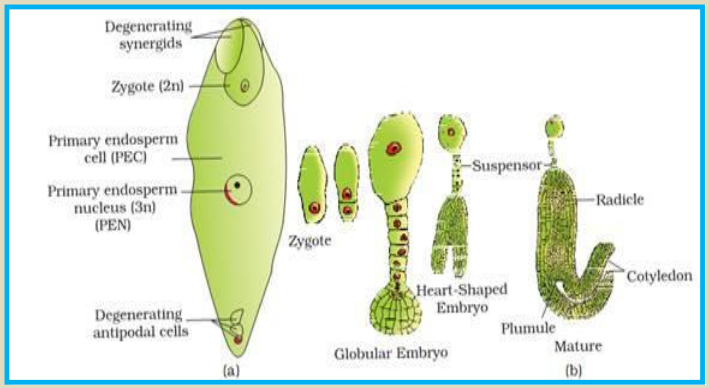
Q8. (i) Explain the structure of a maize grain with the help of a diagram
ii) Why cannot we use the term maize seeds for maize grains?
Ans. (i) In grass family ( eg. Maize ) fruit is single seeded where pericarp & seed coat are fused together to form the husk. Just below husk, there is a layer of cells called aleurone layer, with stores proteins. There is a large endosperm that stores starch. The embryo lies on one side of endosperm & consists of a single cotyledon called scutellum & embryonal axis. The region of embryonal axis that points down ward from point of attachment of cotyledons is radicle & is covered by protective sheath called coleorhiza. The region of embryonal axis that points upward from point of attachment of cotyledon is plumule, it is covered by foliaceous sheath called coleoptite
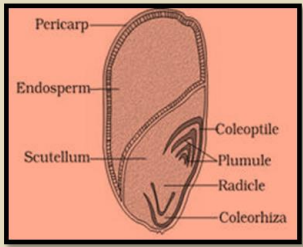
(ii) We cannot use the term seeds for maize grain because seed is not completely developed from embryo but retains a part of endosperm.
Q9. Describe the structure of a pollen grain.
Ans. The pollen grain is normally spherical with two wall layers.
• the outer layer is exine composed of highly resistant organic substance called sporopollenin which is absent at the aperture region called germ pore.
• the inner layer is the in tine which is composed of cellulose and pectin.
• a mature pollen grain has a vegetative cell and a generative cell
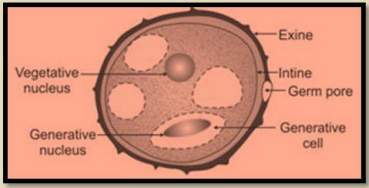
10. WRITE A NOTE ON SPERMATOGENESIS.
Ans. Spermatogenesis is the process by which sperm cells, or spermatozoa, develop in the male reproductive organs, the testes. Here's a concise overview:
- Location: Seminiferous tubules within the testes.
- Process:
- Mitosis: Stem cells divide to produce new stem cells and spermatogonia (immature sperm cells).
- Meiosis: Spermatogonia undergo meiosis, a cell division that halves the number of chromosomes, creating haploid spermatids.
- Spermiogenesis: Spermatids mature into motile, streamlined sperm cells with a head containing genetic material and a tail for movement.
This process is essential for sexual reproduction, ensuring the creation of sperm cells with the correct number of chromosomes for fertilization.
11. Differentiate between Graafian follicle and Corpus luteum.
Ans.
-
Graafian Follicle:
- Definition: A Graafian follicle is a mature ovarian follicle that contains the secondary oocyte (developing egg) and is poised for ovulation.
- Formation: It develops from a tertiary follicle during the menstrual cycle.
- Hormone Secretion: The Graafian follicle secretes estrogen, which plays a crucial role in regulating the menstrual cycle.
- Maintenance: It is developed and maintained by the Follicle Stimulating Hormone (FSH).
- Function: Its primary function is to prepare the egg for release during ovulation.
-
Corpus Luteum:
- Definition: The corpus luteum is a temporary endocrine structure formed in the ovary after ovulation.
- Origin: It arises from the remnants of the Graafian follicle after the egg is released.
- Hormone Secretion: The corpus luteum secretes progesterone, which is essential for maintaining the uterine lining and supporting early pregnancy.
- Maintenance: It is developed and maintained by the Human Chorionic Gonadotropin (HCG) hormone.
- Function: If pregnancy occurs, the corpus luteum continues to function as an endocrine gland to support the developing embryo.
Q12. Explain the hormonal regulation of the process of spermatogenesis in humans.
Ans: Spermatogenesis starts during puberty due to significant increase in the secretion of gonadotropin releasing hormone (GnRH) from the hypothalamus. GnRH acts on the anterior pituitary gland and stimulates secretion of two gonadotropins – Luteinizing Hormone (LH) and Follicle Stimulating Hormone (FSH). LH acts on the Leydig cells and stimulates secretion of testosterone – a principal androgen. Testosterone is essential for sperm formation. Androgen in turn stimulates the process of spermatogenesis. FSH acts on Sertoli cells and stimulates secretion of some factors (like ABP i.e., Androgen Binding Protein) which help in the process of spermiogenesis. They bind to testosterone and concentrate testosterone in seminiferous tubules
Q13. Differentiate Spermatogenesis and Oogenesis.
Ans: The differences are tabulated as follows:.
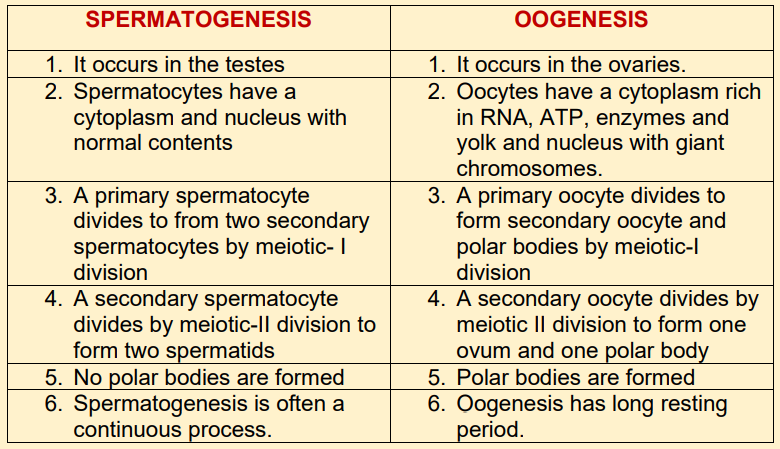
Q 14. Draw a labelled diagram of sperm & explain.
Ans.
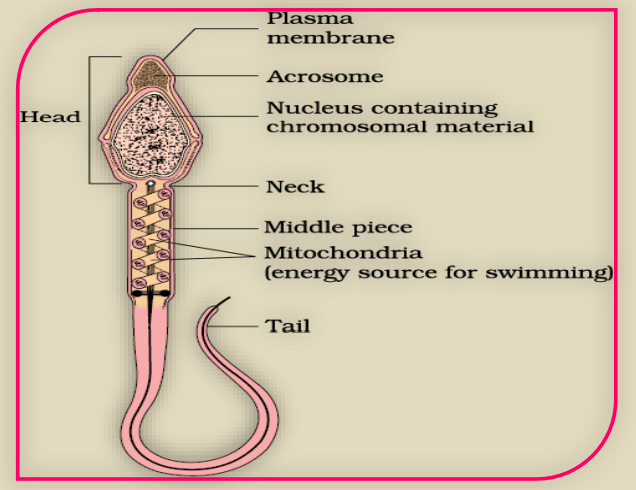
STRUCTURE OF A SPERM (SPERMATOZOA); It consists of four parts – head, neck, middle piece and tail – enveloped by a plasma membrane.
(I) HEAD: The sperm head contains an elongated haploid nucleus, the interior portion of which is cover by a cap like structure acrosome.
(II) NECK: It contains proximal centriole which is necessary for the first cleavage division of zygote and the distal contriole that is connected to the tail filament.
(III) MIDDLE PIECE: Middle piece contain numerous mitochondria which produce energy for the movement of tail.
Q 15. Draw the structure of seminiferous tubule.
Ans.
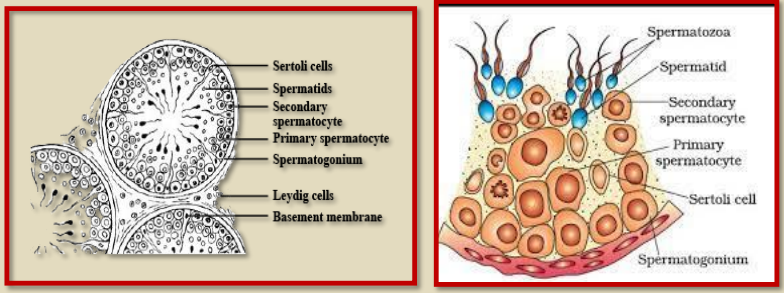
Each seminiferous tubule is lined on its inside by two highly specialised cells called male germ cell (spermatogonia) and Sertoli cells. Spermatogonia undergo meiotic cell division to produce sperms. Sertoli cells or nurse cells provide nutrition to the germ cells. The regions outside the seminiferous tubules contain masses of cells called interstitial cells or Leydig cells.
Q16. Draw a labelled diagram of the embryonic stage that gets implanted in the human uterus. State the functions of the two parts labelled.
Ans.
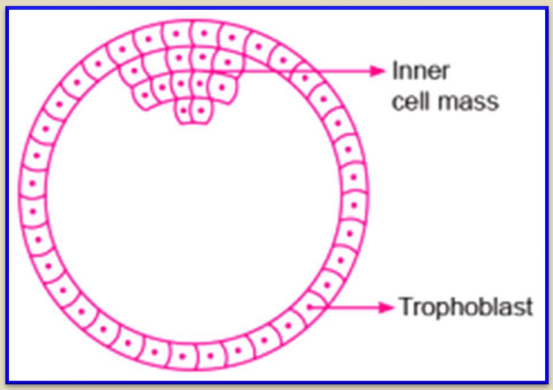
Trophoblast helps in implantation or attachment to endometrium.
Inner cell mass gets differentiated into an embryo.
Q17. Differentiate between sperm and ova.
Ans: The differences are tabulated as follows:
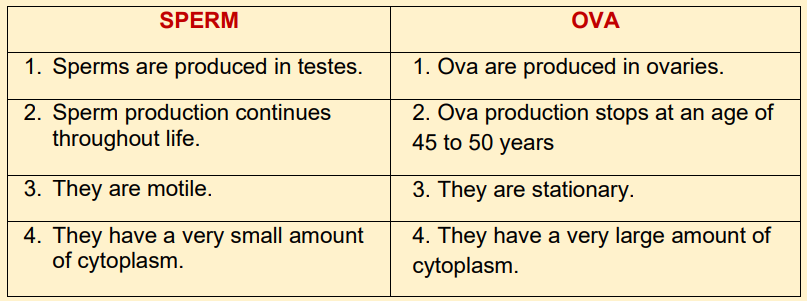
18. What are the causes of Infertility in Females?
Ans. Causes of Infertility in Females:
(a)Anovulation (no ovulation). There is no corpus luteum formation. There is oligoovulation (deficient ovulation).
(b)There is luteal phase defect (LPD)- drug induced ovulation, decreased level of FSH and/or LH.
(c)Defective growth of uterus and vagina.
(d)Uterine factor includes unfavourable endometrium for implantation chronic endomeritis (TB), fibroid uterus, etc.
(e)Cervical factor includes ineffective sperm penetration chronic cervicitis, presence of antisperm antibody, elongation of cervix.
(f) Fimbriae of the Fallopian tube may not pick up secondary oocyte from the ovary.
(g)Dyspareunia (painful sexual intercourse experienced by a woman).
(h)Increased sperm phagocytosis by macrophages.
(i) Fertilization and implantation problems
19. What are the causes of Infertility in Males?
Ans. Causes of Infertility in males :
(a)Cryptochoridism - it is a condition in which testes are unable to descend in scrotal sacs so that sperms are not produced- azospermia.
(b)Alcoholism causes defective spermatogenesis.
(c)Thyroid dysfunction.
(d)Impotency.
(e)Gonadotrophin (LH, FSH) deficiency.
(f) Use of antihypertensive and antipsychotic drugs for a long time.
(g)Immotile cilia - sperms are unable to move from vagina to the upper portion of the genital tract of the female.
(h)Y-chromosome deletions.
(i) Blockage of vasa deferentia and vasa efferentia.
(j) Acquired infection like mumps, infection of seminal vesicle and prostate cause oligospermia (poor sperm count).
20. Differentiate between dominance, codominance and incomplete dominance with one example each.
Ans: The differences between dominance, codominance and incomplete dominance with one example are as follows:
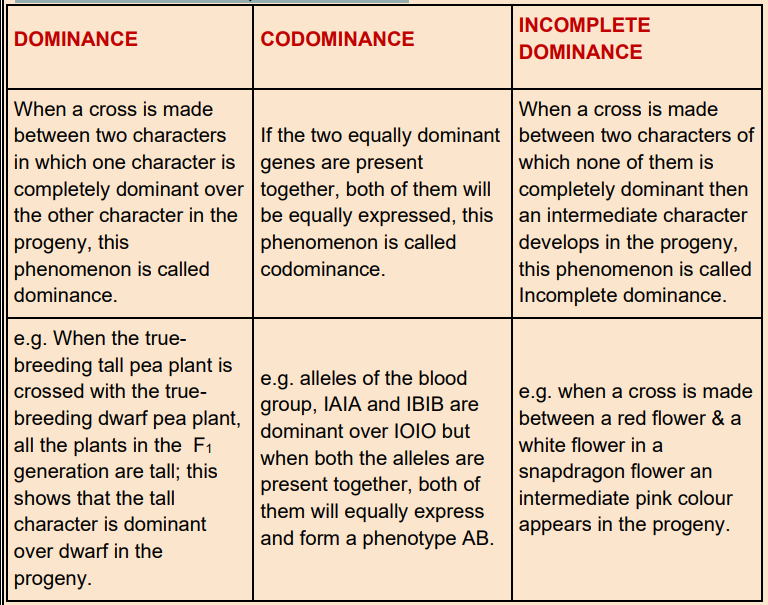
Bonus Tip: Share this resource with your classmates and study together! Group discussions can further strengthen your understanding and make learning even more fun.
-
Punjab Board Class 10 Study Material
| Punjab Board Class 10 Study Material | |
| Punjab Board Class 10 Books | Punjab Board Class 10 Syllabus |
| Punjab Board Class 10 Textbook Solutions | |







 Profile
Profile Signout
Signout












 Quiz
Quiz
 Get latest Exam Updates
Get latest Exam Updates 










